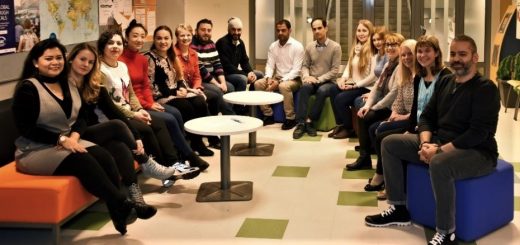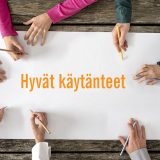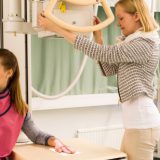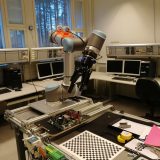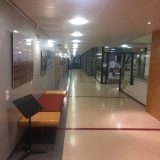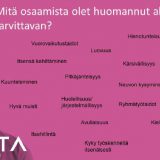This Autumn – Full of Collaboration

International interprofessional collaboration – together you know more than alone. Student are Sjoerd (left), Miloslawa, Malgorzata, Petri and Eerik. (Picture: Sjoerd Damen.)
Expertise for the future
This autumn the students completed the course called Trauma Imaging and Interprofessional Collaboration in Oulu University of Applied Sciences. In the group there were people from three different countries with backgrounds in different fields, like occupational therapy, physiotherapy, radiography, nursing, dental hygiene, paramedics, and podiatry. This was the first time when students studied together with dental hygiene and podiatry students. It was interesting to have them on the course, since everyone had such a different point of view when approaching the learning triggers. The whole course of 3 ECTS was carried out during four weeks.
The students had classes once per week, and for each meeting they prepared a solution for the trigger of the trauma patient by using their fields as much as possible. The students learned a lot from each other during this course. All worked very hard, and had also a lot of fun.
Learning to solve triggers together
During the first lesson the students studied the problem-based learning (PBL) process of clarifying the concepts, defining the problem, brain storming for analysing the problem, taking information beside the learning objectives of their own field of expertise, defining the objectives in the form of learning outcomes, and acquiring knowledge in relation to the trigger. First the students were divided into the groups of 4–5 students, and each group had representatives of different professional fields. Each group contained a varied range of students from different fields. Then the groups were presented with a scenario of an imaginary accident. There were a total of three triggers or scenarios, each having one photo of the accident. First, the patients had fallen from ladders, later on the triggers were about high energy car accidents. Then they made presentations in groups, which were presented to whole class.
The presentations were made based on different sources as research articles, text books, videos etc. and presented by Word documents or PowerPoint presentations. The main goal for each student was to teach something to the others during these presentations, while they had first learned about their specific learning objective. One requirement while choosing the learning objective was that it had to offer some new knowledge for the presenting students themselves as well as to the audience. After the presentations had been held, a new trigger was introduced and the process started from the beginning again. During the last lesson the students got to choose if they wanted to write a report or a blog, answering how the course had advanced their expertise and how and what they had learned during the course.
Experts sharing their knowledge
Explaining PBL in a few words could be that it is a learning method in which students get skills and knowledge by working for a period of time to validate and find answers to authentic, complex problems or challenges. It is a style of active learning. PBL is focused on the student’s learning goals for becoming a 21st century’s professional such as:
- personal and social responsibility,
- planning, critical thinking, reasoning and creativity,
- strong communication skills, both for interpersonal and presentations,
- visualizing and decision making,
- crosscultural understanding and
knowledge of how to use technology and the proper tool for your task.
When the students chose the patient, they brainstormed briefly and made a lot of suggestions about the future assignments, before considering them carefully. After every presentation they got feedback, from other groups and from the teacher. It helped them to understand more about the details. As health care students they need to know how to cooperate with each other and broaden their horizons to understand the point of view from different professions, not only from theirs. Given tasks showed that every profession has his own role while helping the patients that they need to work together if they want to provide the good healthcare.
During the course the students had many different learning objectives. For example, the dental hygienist told us how a dental implant works, how a collar is placed into the jaw and how later on a permanent crown can be cemented or screwed on its place. In addition, the paramedics explained primary survey, the nurses told about patient´s care and the radiographers told the class a lot about radiological examinations and radiation protection of patients and staff and how radiation and contrast medium are used in medicine. Since the course was partially about trauma imaging, they discussed CT scanning a lot since it is much used in emergency cases. An occupational therapist showed us a lot of different useful tools while working with clients, etc.
Seeing the bigger context
The course objective was to learn to understand the basics of trauma imaging and interprofessional collaboration, as well as assessment and general principles of care of a trauma patient. This was performed through various cases, which were prepared and presented in groups that were formed during the first lesson.
The learning method used on this course proved to be quite effective. Instead of just getting the answers from books, you actually had to visualize the situation in your mind, and think of anatomy and physiology, many possible injuries, their mechanisms, and how to treat them. It was also fun to notice how people with different educational backgrounds could see different injuries in the same picture. For example, where an occupational therapist sees a torn ligament, a radiographer sees a broken thighbone and so on.
The outcome of the course was a wealth of new information. For example, as a radiographer it was interesting to learn the ways and methods of an occupational therapist and physiotherapist in the rehabilitation of a patient with a torn knee ligament. It was also interesting to learn each professions role in the overall care of the patient. We believe that the lessons learnt on this course will help all of them in their future jobs on the field of patient care and welfare.
Malgorzata Magusiak, Occupational therapy student
University School of Physical Education in Wroclaw
Miloslawa Szotek, Occupational therapy student
University School of Physical Education in Wroclaw
Eerik Sternberger, Radiography and radiation therapy student
Oulu University of Applied Sciences
Sjoerd Damen, Physiotherapy student
Fontys University of Applied Sciences in Eindhoven
Petri Manninen, Radiography and radiation therapy student
Oulu University of Applied Sciences
Aino-Liisa Jussila; Senior lecturer
Oulu University of Applied Sciences



